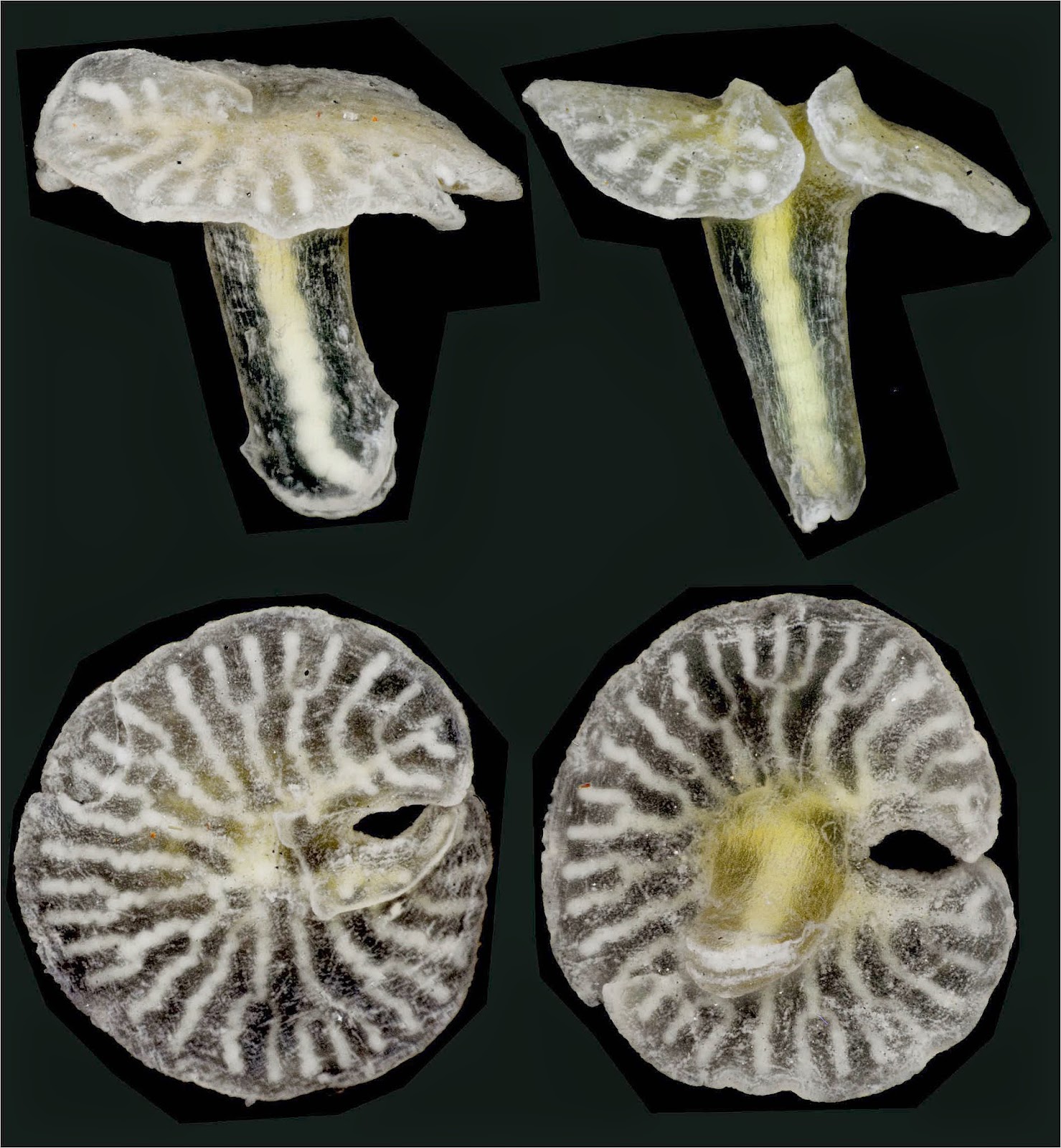 |
| Figure 1. Dendrogramma gen. nov., paratypes of D. enigmatica and (with *) D. discoides. |
 |
| Figure 3. Dendrogramma enigmatica sp. nov., holotype. |
Abstract
A new genus, Dendrogramma, with two new species of multicellular, non-bilaterian, mesogleal animals with some bilateral aspects, D. enigmatica and D. discoides, are described from the south-east Australian bathyal (400 and 1000 metres depth). A new family, Dendrogrammatidae, is established for Dendrogramma. These mushroom-shaped organisms cannot be referred to either of the two phyla Ctenophora or Cnidaria at present, because they lack any specialised characters of these taxa. Resolving the phylogenetic position of Dendrogramma depends much on how the basal metazoan lineages (Ctenophora, Porifera, Placozoa, Cnidaria, and Bilateria) are related to each other, a question still under debate. At least Dendrogramma must have branched off before Bilateria and is possibly related to Ctenophora and/or Cnidaria. Dendrogramma, therefore, is referred to Metazoa incertae sedis. The specimens were fixed in neutral formaldehyde and stored in 80% ethanol and are not suitable for molecular analysis. We recommend, therefore, that attempts be made to secure new material for further study. Finally similarities between Dendrogramma and a group of Ediacaran (Vendian) medusoids are discussed.
 |
| Figure 1. Dendrogramma gen. nov., all 15 paratypes of D. enigmatica and (with *) D. discoides. Photographs taken after shrinkage (see Material and Methods). |
Metazoa
It has been suggested during review that Dendrogramma could represent a new non-bilaterian phylum. While we may agree, we refrain from erecting such a high-level taxon for the time being, because new material is needed to resolve many pertinent outstanding questions.
Dendrogrammatidae, new family
Diagnosis: Multicellular, mesogleal, apparently diploblastic animal. Body divided into cylindrical stalk and broad, flat disc (Figs 2A, B, 3, 4, 5A, 7). Simple round mouth opening situated in slightly depressed lobed field on rounded apex of stalk. With gastrovascular system comprising a simple tube centrally in stalk (pharynx) running from mouth to base of disc, then branching dichotomously, including first branching node (Fig. 6B), in disc at right angles to stalk. Epidermis composed of single layer of low, uniform cells; gastrodermis composed of single layer of elongate, vacuolated cells tapering towards narrow gastrovascular canal (pharynx) (Fig. 2C); epidermis of mouth-field lobes with thickened, elongate, apparently vacuolated/glandular cells (Fig. 2D). Dense mesoglea milky translucent when formalin fixed except for refractive sheath of spongiose mesoglea surrounding gastrodermis of gastrovascular canal in stalk (pharynx) (Figs 2C, 5C). Mesoglea criss-crossed by fibrils including cylindrical sheet under epidermis (Fig. 2C, D).
Dendrogramma, new genus
Diagnosis: With the characters of the family.
Etymology: The name of the genus alludes to the branching pattern of the gastrovascular system of the disc.
Type-species: Dendrogramma enigmatica new species.
Etymology: This species has been and still is a great enigma.
Additional species: Dendrogramma discoides new species.
Etymology: This species is named for the shape of the disc.
 |
| Figure 3. Dendrogramma enigmatica sp. nov., holotype. A, B, lateral views; C, aboral view, D, adoral view. Photographs taken after shrinkage. |
Jean Just, Reinhardt Møbjerg Kristensen and Jørgen Olesen. 2014. Dendrogramma, New Genus, with Two New Non-Bilaterian Species from the Marine Bathyal of Southeastern Australia (Animalia, Metazoa incertae sedis) – with Similarities to Some Medusoids from the Precambrian Ediacara.
PLoS ONE 9 (9): e102976. DOI: 10.1371/journal.pone.0102976
Skinner, Nicole. 2014. Sea creatures add branch to tree of life. Nature. doi: 10.1038/nature.2014.15833.
